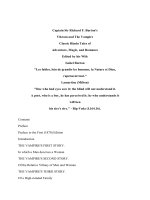Girsanov’s theorem and the risk-neutral measure
Bạn đang xem bản rút gọn của tài liệu. Xem và tải ngay bản đầy đủ của tài liệu tại đây (187.39 KB, 8 trang )
Chapter 17
Girsanov’s theorem and the risk-neutral
measure
(Please see Oksendal, 4th ed., pp 145–151.)
Theorem 0.52 (Girsanov, One-dimensional) Let
B t; 0 t T
, be a Brownian motion on
a probability space
; F ; P
.Let
F t; 0 t T
, be the accompanying filtration, and let
t; 0 t T
, be a process adapted to this filtration. For
0 t T
, define
e
B t=
Z
t
0
udu + B t;
Z t = exp
,
Z
t
0
u dB u ,
1
2
Z
t
0
2
u du
;
and define a new probability measure by
f
IP A=
Z
A
ZTdIP; 8A 2F:
Under
f
IP
, the process
e
B t; 0 t T
, is a Brownian motion.
Caveat: This theorem requires a technical condition on the size of
.If
IE exp
1
2
Z
T
0
2
u du
1;
everything is OK.
We make the following remarks:
Z t
is a matingale. In fact,
dZ t=,tZtdB t+
1
2
2
tZtdB t dB t ,
1
2
2
tZ t dt
= ,tZ t dB t:
189
190
f
IP
is a probability measure. Since
Z 0=1
,wehave
IEZt=1
for every
t 0
. In particular
f
IP =
Z
Z T dIP = IEZT =1;
so
f
IP
is a probability measure.
f
IE
in terms of
IE
. Let
f
IE
denote expectation under
f
IP
.If
X
is a random variable, then
f
IEZ = IE ZT X :
To see this, consider first the case
X = 1
A
,where
A 2F
.Wehave
f
IEX =
f
IP A=
Z
A
ZTdIP =
Z
Z T 1
A
dIP = IE Z T X :
Now use Williams’ “standard machine”.
f
IP
and
IP
. The intuition behind the formula
f
IP A=
Z
A
ZTdIP 8A 2F
is that we want to have
f
IP !=ZT; !IP !;
but since
IP ! =0
and
f
IP !=0
, this doesn’t really tell us anything useful about
f
IP
. Thus,
we consider subsets of
, rather than individual elements of
.
Distribution of
e
B T
. If
is constant, then
Z T = exp
n
,BT ,
1
2
2
T
o
e
B T =T + BT :
Under
IP
,
B T
is normal with mean 0 and variance
T
,so
e
B T
is normal with mean
T
and
variance
T
:
IP
e
B T 2 d
~
b=
1
p
2T
exp
,
~
b , T
2
2T
d
~
b:
Removal of Drift from
e
B T
. The change of measure from
IP
to
f
IP
removes the drift from
e
B T
.
To see this, we compute
f
IE
e
B T =IEZTT + BT
= IE
h
exp
n
,BT ,
1
2
2
T
o
T + BT
i
=
1
p
2T
Z
1
,1
T + b expf,b ,
1
2
2
T g exp
,
b
2
2T
db
=
1
p
2T
Z
1
,1
T + b exp
,
b + T
2
2T
db
y = T + b=
1
p
2T
Z
1
,1
y exp
,
y
2
2
dy
(Substitute
y = T + b
)
=0:
CHAPTER 17. Girsanov’s theorem and the risk-neutral measure
191
We can also see that
f
IE
e
B T =0
by arguing directly from the density formula
IP
n
e
B t 2 d
~
b
o
=
1
p
2T
exp
,
~
b , T
2
2T
d
~
b:
Because
Z T = expf,BT ,
1
2
2
T g
= expf,
e
B T , T ,
1
2
2
T g
= expf,
e
B T +
1
2
2
Tg;
we have
f
IP
n
e
B T 2 d
~
b
o
= IP
n
e
B T 2 d
~
b
o
exp
n
,
~
b +
1
2
2
T
o
=
1
p
2T
exp
,
~
b , T
2
2T
,
~
b +
1
2
2
T
d
~
b:
=
1
p
2T
exp
,
~
b
2
2T
d
~
b:
Under
f
IP
,
e
B T
is normal with mean zero and variance
T
. Under
IP
,
e
B T
is normal with
mean
T
and variance
T
.
Means change, variances don’t. When we use the Girsanov Theorem to change the probability
measure, means change but variances do not. Martingales may be destroyed or created.
Volatilities, quadratic variations and cross variations are unaffected. Check:
d
e
Bd
e
B=tdt + dB t
2
= dB :dB = dt:
17.1 Conditional expectations under
f
IP
Lemma 1.53 Let
0 t T
.If
X
is
F t
-measurable, then
f
IEX = IEX:Z t:
Proof:
f
IEX = IEX:ZT = IE IE X:ZT jFt
= IE XIEZTjF t
= IE X:Zt
because
Z t; 0 t T
, is a martingale under
IP
.
192
Lemma 1.54 (Baye’s Rule) If
X
is
F t
-measurable and
0 s t T
,then
f
IE X jF s =
1
Z s
IE XZtjF s:
(1.1)
Proof: It is clear that
1
Z s
IE XZtjF s
is
F s
-measurable. We check the partial averaging
property. For
A 2Fs
,wehave
Z
A
1
Z s
IE XZtjF s d
f
IP =
f
IE
1
A
1
Z s
IE XZtjF s
= IE 1
A
IE XZtjF s
(Lemma 1.53)
= IE IE 1
A
XZtjF s
(Taking in what is known)
= IE 1
A
XZt
=
f
IE 1
A
X
(Lemma 1.53 again)
=
Z
A
Xd
f
IP:
Although we have proved Lemmas 1.53 and 1.54, we have not proved Girsanov’s Theorem. We
will not prove it completely, but here is the beginning of the proof.
Lemma 1.55 Using the notation of Girsanov’s Theorem, we have the martingale property
f
IE
e
B tjF s =
e
B s; 0 s t T:
Proof: We first check that
e
B tZ t
is a martingale under
IP
. Recall
d
e
B t=tdt + dB t;
dZ t=,tZt dB t:
Therefore,
d
e
BZ=
e
BdZ+Zd
e
B+d
e
BdZ
=,
e
BZ dB + Z dt + ZdB,Z dt
=,
e
BZ + Z dB :
Next we use Bayes’ Rule. For
0 s t T
,
f
IE
e
B tjF s =
1
Z s
IE
e
B tZ tjF s
=
1
Z s
e
B sZ s
=
e
B s:
CHAPTER 17. Girsanov’s theorem and the risk-neutral measure
193
Definition 17.1 (Equivalent measures) Two measures on the same probability space which have
the same measure-zero sets are said to be equivalent.
The probability measures
IP
and
f
IP
of the Girsanov Theorem are equivalent. Recall that
f
IP
is
defined by
f
IP A=
Z
ZTdIP; A 2F:
If
IP A=0
,then
R
A
Z T dIP =0:
Because
Z T 0
for every
!
, we can invert the definition
of
f
IP
to obtain
IP A=
Z
A
1
ZT
d
f
IP; A 2F:
If
f
IP A=0
,then
R
A
1
Z T
dIP =0:
17.2 Risk-neutral measure
As usual we are given the Brownian motion:
B t; 0 t T
, with filtration
F t; 0 t T
,
defined on a probabilityspace
; F ; P
. We can then define the following.
Stock price:
dS t=tStdt + tS t dB t:
The processes
t
and
t
are adapted to the filtration. The stock price model is completely
general, subject only to the condition that the paths of the process are continuous.
Interest rate:
rt; 0 t T
. The process
rt
is adapted.
Wealth of an agent, starting with
X 0 = x
. We can write the wealth process differential in
several ways:
dX t= t dS t
| z
Capital gains from Stock
+ rtX t , tS t dt
| z
Interest earnings
= rtX t dt +tdS t , rS t dt
= rtX t dt +tt, rt
| z
Risk premium
S t dt +ttStdB t
= rtX t dt +ttSt
2
6
6
6
6
4
t,rt
t
| z
Market price of risk=
t
dt + dB t
3
7
7
7
7
5









